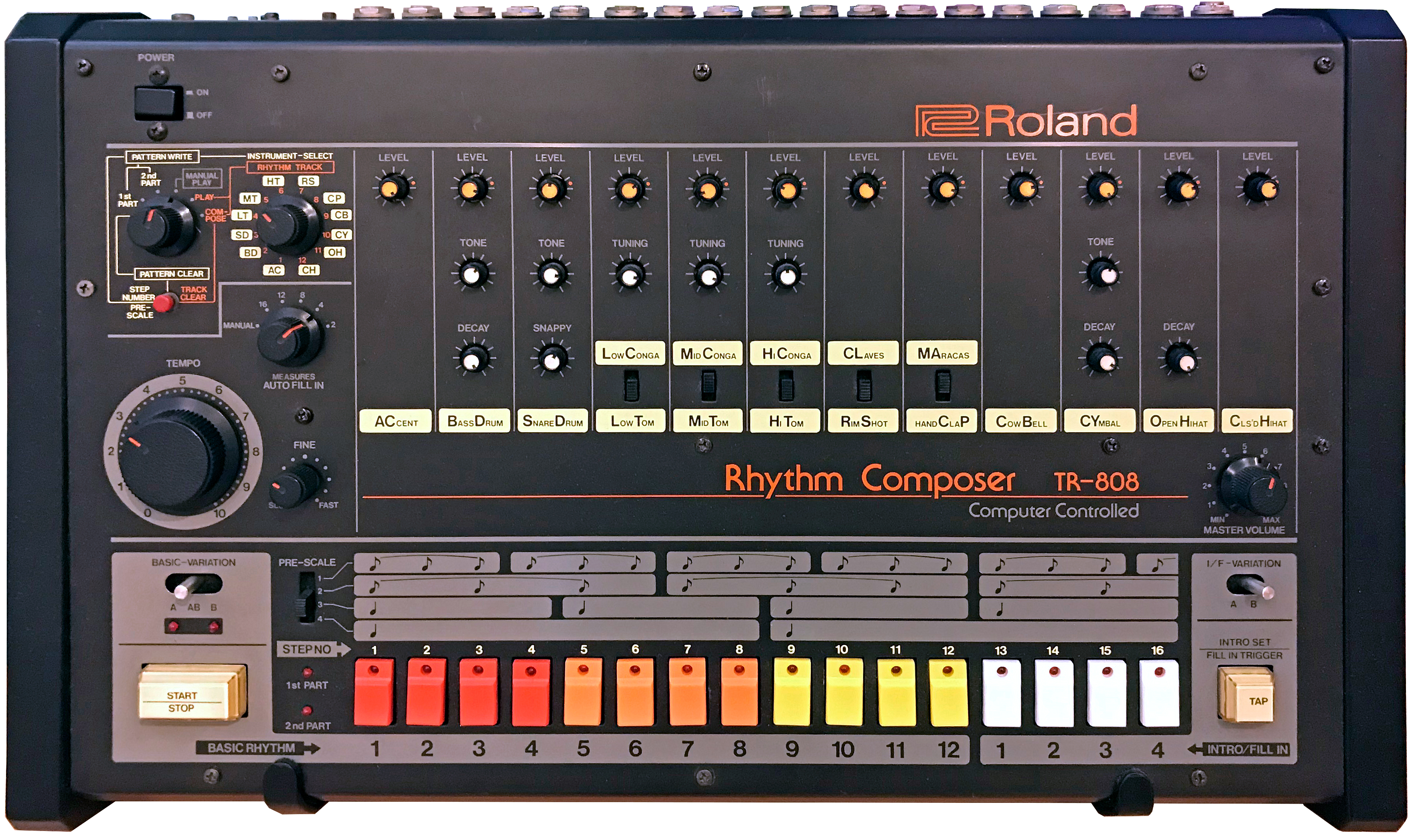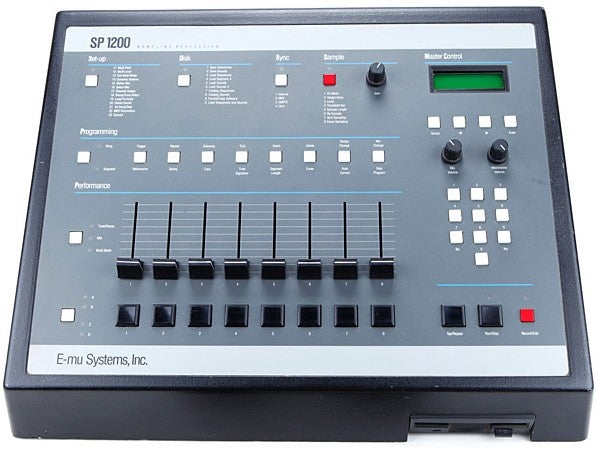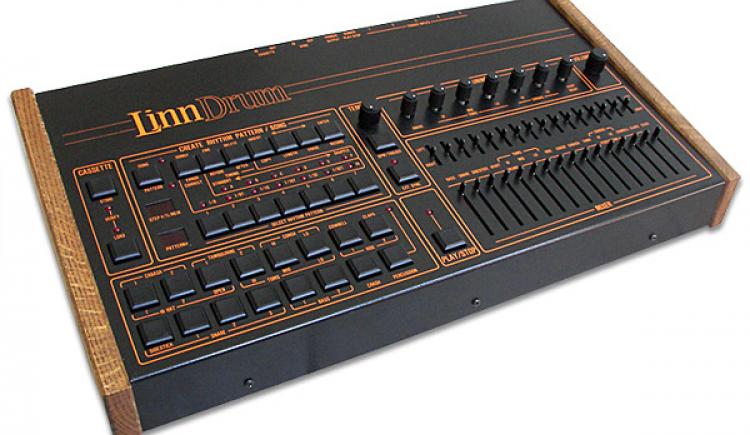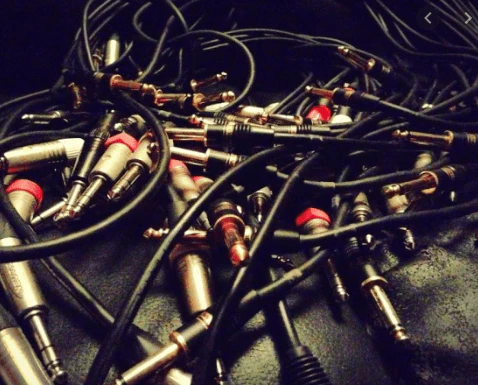Instruments of Innovation: The Most Influential Music Gear of our times.
From time to time a piece of influential music gear will come along and create seismic shockwaves. It may birth an entire genre or change the sound and direction of an established musical style. In this list we take a look at 5 such pieces of music kit and consider the profound effects they have had on the modern musical landscape.
1: Roland TR808

- Year released: 1980
- Genre(s) influenced: Electro, Hip-Hop, 80’s Soul, Chicago House, Trap, Phonk (808 cowbell)
- Key exponents: Mantronix, Frankie Knuckles, Young Thug
- Key tracks: Planet Rock – Afrika Bambatta & the Soul Sonic Force, Sexual Healing – Marvin Gaye, Mask Off – Future
There really was no competition when it came to the top spot. An instrument so prolific that the 3 digits making up its name have practically become a household name. The Roland TR-808 drum machine, initially designed as a substitute for live drummers, faced an uncertain start due to its somewhat artificial ‘tin can’ sounding drums. It’s sounds paled in comparison to the more authentic tones of machines like the LinnDrum and it therefore didn’t perform well on its original release.
However, fate took a turn with the release of the genre-defining “Planet Rock” by Afrika Bambaataa and the Soul Sonic Force in 1982. Drawing inspiration from the futuristic sounds of Kraftwerk and Gary Numan, this track birthed a new genre known as Electro Funk or simply Electro. This exciting new offshoot of Hip-Hop would set the stage for the TR-808’s influential journey.
As its use expanded, the TR-808 would also find a place in pop music, notably leaving its mark on Marvin Gaye’s iconic “Sexual Healing,” as well as Phil Collins, something in the air tonight.
But it was in the realm of hip-hop that the TR-808 truly found its home. As hip-hop evolved, the tempo slowed down, allowing for the distinctive “boom kick” of the TR-808 to shine. Artists like Run DMC with “Together Forever, and the Rick Rubin produced “It’s Yours,” by T La Rock skillfully incorporated the 808’s booming kicks and snappy snares. Meanwhile in Miami producer Luke Skywalker was instrumental in the birth of the Miami bass sound which also embraced the 808’s capacity for bass-heavy pumping uptempo beats.
During the same period over in Chicago, early DJ/producers such as Frankie Knuckles and Marshall Jefferson used the 808 to create the ‘4 to the floor’ rhythmic template that would help define House music. This 808-infused pioneering work would go on to lay the foundation for electronic dance music’s future.
The 808’s popularity took a slight dip in the ’90s, partly due to its elder sibling the TR909 having its time in the sun. By the 0’s the 808 was well and truly back on the musical map with the development of Trap Music. Trap’s signature sound, characterized by heavily pitched 808 bass and intricate hi-hat patterns reminiscent of machine gun fire, owes its entire essence to the TR-808. Even the humble and once-overlooked clap, would gain prominence within the idiom of trap.
Trap’s meteoric rise would extend beyond its genre boundaries, infiltrating R&B and pop music scenes. Even the often-overlooked cowbell has been reinvented as a melodic tool in Phonk music. It’s safe to say the TR-808 has now become a staple in modern music production, touching nearly every genre and artist. showcasing its enduring impact and versatility.
2: Yamaha DX7

- Year released: 1983
- Genre(s) influenced: 80s pop, rock, soul, Hi-NRG, House, Synthwave
- Key exponents: Stock Aitkin and Waterman, Trevor Horn, Carpenter Brut
- Key tracks: The Final Countdown – Europe, Axel F – Harold Faltermeyer, You Should Be So Lucky – Kylie Minogue
When you think of that iconic 80s sound two instruments stand out as playing a pivotal role. While the LinnDrum would dominate the rhythms of the 80’s few would deny that the Yamaha DX represents THE melodic sound of that decade.
While Rolands Juno and Jupiter synths were also prolific during this time, the Yamaha DX7 stood out as the ebony and ivoried icon of that period. What set the DX7 apart was its use of FM synthesis, a departure from the analogue sounds of previous synths. This innovation gave the DX7 a bright and clean slightly more realistic sound.
While the DX7 heralded a new dawn in instrument realism it certainly didn’t when it came to programmability. It’s challenging programming interface, led to most musicians and producers relying heavily on its presets. This resulted in certain sounds, such as its brass, electric piano, and bass’s, becoming synonymous with the DX7 and widely overused in ’80s music.
Arpeggiated basslines utilising the DX7’s synth bass sound, became the backbone and driving force behind many dancefloor pop hits of the 80s. Most notably they formed the template to prolific 80s producers Stock Aitken and Waterman’s distinctive pop rhythms. Who knows? Without the DX7 we may not have had Stock, Aitken & Waterman tracks bothering the top 10 on a weekly basis. (which some may view as a positive)
In fact, it’s hard to find a genre from the ’80s that wasn’t touched by the DX7 in some way. Its influence was widespread and undeniable.
In more recent times, there’s been a resurgence of interest in the DX7’s sounds, particularly in vintage-tinged genres such as synthwave and vaporwave. Artists and producers are revisiting these classic tones to evoke a sense of nostalgia, showcasing the timeless appeal of the Yamaha DX7 even decades after its heyday.
3: Emulator SP12/ SP1200

- Year released: 1986/1987
- Genre(s) influenced: Hip-Hop, RnB, House
- Key exponants: Marley Marl, Pete Rock, Easy Mo B
- Key tracks: Flavour in ya ear, They Reminisce over you, Think of RnB one
During the later half of the 1980s a musical revolution took place. Pioneered in the burgeoning Hip-Hop scene, sampling was birthed and would go on to influence every corner of the musical landscape.
The original intention of these early sampling devices was to capture melodic and rhythmic one-shots for a more realistic form of synthesis. But these companies hadn’t reckoned on a bunch of urban musical renegades intent on capturing and replaying the sort of breakbeat recordings that were a cornerstone of this musical sub-culture. Pioneering Hip-Hop producers such as Marley Marl, Ced Gee and Paul C would utilise this newly affordable sampling technology in astonishingly creative ways. For example, individual drum hits from old break records were sampled and used to program funky new drum patterns. Producers would also loop tasty sections from old records, most notably James Brown’s extensive back catalogue as well as create interesting effects with stabs and sound fx. This was a totally new and revolutionary concept.
And the sampler that afforded these producers the ability to sample so creatively was the Emulator SP12, followed a year later by the SP1200. And although the SP’s technology compared to today’s samplers was primitive, inventive ways were used to get around the limitations. For example, by sampling old records in at 45rpm and then pitching them back down Hip-Hop producers could maximise the 10-second sample time and create entire songs inside these machines. This created a distinctive 12-bit anti-aliasing effect that would become the sound of so much 90s Hip-Hop.
And it wasn’t just Hip-Hop that fell in love with the incredibly phat and punchy 12-bit sound of the SP. In House music Marshall Jefferson, Todd Terry, Frankie Knuckles and Mr Fingers are all credited as avid users. It was also used extensively in the realms of RnB.
After a while however as technology progressed the SP’s top spot was beginning to be threatened. Mainly in the form of Akai’s MPC samplers. One thing cannot be disputed though. The SP 1200 can certainly lay claim to being the sampler that kick started and enabled the whole sampling revolution. And that is why it gets such a high position in our Top 7 list.
4: The LinnDrum

- Year released: 1982
- Genre(s) influenced: 80s Pop, Rock and Soul,
- Key exponents: Michael Jackson, Eurythmics, Human League
- Key tracks: All Night Long – Mary Jane Girls, Michael Jackson – Thriller, When Doves Cry – Prince
While the DX7 dictated the melodic timbre of the 1980s when it came to the rhythm tracks there was one drum machine that ruled the roost. I talk of course of the LinnDrum.
The impact of the LinnDrum in shaping the rhythmic landscape of the 1980s cannot be overstated. Unlike its predecessors, the LinnDrum, named after its creator Roger Linn, revolutionized drum machines by storing real drum sounds on chips. This led to a much cleaner and natural sound that was far more realistic than it’s competitors. This set the LinnDrum apart making it the drum machine of choice for most professional studios of the time.
Various models of LinnDrum were released including the LM-1 and Linn 9000. While many studios and producers embraced these machines they also marked a turning point where real drummers felt the first hints of competition from a machine. This was a time when there was a growing trend toward a more synthesized, artificial sound in popular music production. This shift, coupled with advancements in recording technology and studios, solidified the LinnDrum’s influence across multiple genres.
In the mid-’80s, Stock Aitken and Waterman, propelled the Linn 9000, alongside the DX7, to dominance in the charts, shaping the sound of mainstream pop throughout the decade. However, as musical tastes evolved with the influences of Hip-Hop and House music emerging, the LinnDrum eventually yielded its spotlight to machines like the TR-909 as well as sampled drum loops.
The LinnDrum may have fallen out of fashion by the late 80s but Roger Linn’s impact would extend beyond the LinnDrum. He played a pivotal role in developing the Akai MPC60 and 3000, which became staples in hip-hop production. Legendary producers like DJ Premier and the late great J Dilla would embrace these new tools, continuing Linn’s legacy in shaping the rhythmic foundations of late 20th-century music.
5: Roland TB303

- Year released: 1981
- Genre(s) influenced: Acid House
- Key exponents: The Prodigy, Aphex Twin, Orbital
- Key tracks: Higher State of Consciousness – Josh Wink, Ragga Twins – Voodoo Ray -A Guy Called Gerald, Da Funk – Daft Punk
While most of the inclusions on this list have influenced multiple wide-ranging genres this one is a tad more neich. But without this funny little device, there would certainly be no – Acid House. And without Acid House and its infamous acid house parties who knows what direction house and dance music would have taken? It’s certainly the case, particularly here in the UK that acid house firmly put electronic dance music on the map. And while it was the lurid drug-fulled all-night raves that commanded the headlines, for the ravers it was all about the strangely intoxicating and repetitive music.
And at the very core of this music lay the TB303 bassline machine. Released in 1981 it was originally intended to be used as a bass guitar replacing counterpart to the TR606 drum machine. A frankly laughable prospect considering the electronic warblings the unit produced. On it’s original release the 303 was therefore rightfully panned and considered a huge commercial flop. If it wasn’t for its subsequent reimagining, it would have surely represented an embarrassing footnote in Roland’s otherwise illustrious musical legacy. BUT reimagined it was and its initial failings were the very thing that would eventually make this unit so iconic. The 303 was rediscovered and repurposed as an implement for House music basslines in the Mid 80’s. Chicago producers Phuture are widely credited for introducing the 303 to house with their track Acid Tracks.
The 303 allowed for simple step programming of basslines along with a nice little note accenting feature. Once you had knocked up a catchy B-Line you could easily manipulate it with these knobs to create a distinctively squidgy effect that sounds like nothing else. By manually twiddling the Cut Off Frequency, Resonance and Env Mod dials you are instantly transported to the planet Acieeeeed. Iconic tracks such as Josh winks Higher State of Consciousness and Guy Called Geralds Voodoo Ray showcased this sound and for a few years between 86 and 89 Acid House was king!
Remember – RouteNote Create subscriptions start from as little as $2.99. You also get 10 FREE credits to spend on samples along with access to our FREE sample pack bundle when you sign-up!
